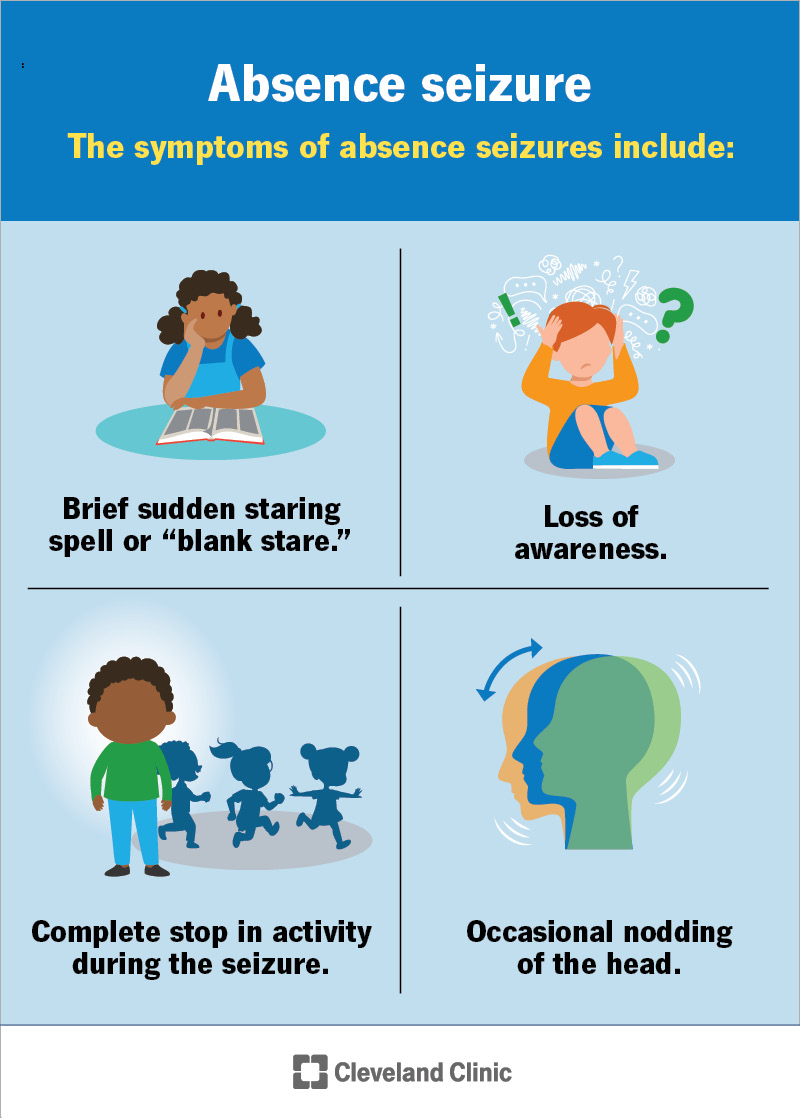Absence seizures are short seizures that happen without warning and usually last for a few seconds. They’re more common in children but adults can have absence seizures, too. Absence seizures are often mistaken for daydreaming or a lack of attention. Antiseizure medications treat this type of seizure.
Advertisement
Cleveland Clinic is a non-profit academic medical center. Advertising on our site helps support our mission. We do not endorse non-Cleveland Clinic products or services. Policy

Absence seizures, formerly known as petit mal seizures, are short seizures that cause you to stare and lose awareness of your surroundings. They typically start without warning and last between three and 15 seconds. Absence seizures are common in children but also happen in adults.
Advertisement
Cleveland Clinic is a non-profit academic medical center. Advertising on our site helps support our mission. We do not endorse non-Cleveland Clinic products or services. Policy
You might be in the middle of an activity, talking to someone or listening to a conversation, when suddenly, you stop. Within a few seconds, you jump back into the activity or conversation as if nothing happened.
For someone unfamiliar with what’s going on inside of your brain, it may seem like you’re daydreaming, distracted or not paying attention when, in fact, a seizure is taking place.
Absence seizures are a type of generalized seizure. They’re either typical or atypical. A healthcare provider can help you manage these seizures with medications.
Absence seizures affect an estimated 6 to 8 out of every 100,000 children younger than 15 years old each year. Absence seizures in adults are less common.

The symptoms of absence seizures include:
After the seizure, you may:
Advertisement
Absence seizure symptoms can happen several times per day or occasionally for weeks to months.
No. You won’t be aware during an absence seizure. Symptoms happen within a few seconds, so the temporary disturbance may or may not interfere with a conversation or task that you were doing since you can jump back into it when the seizure is over.
However, if two or more seizures happen close together, you may look or act confused and lose your place in what’s going on around you. For example, during the seizure, you may miss hearing instructions from teachers or what was said in a conversation.
On average, typical absence seizures last between three and 15 seconds. Atypical absence seizures can last longer.
A burst of electrical activity in your brain causes an absence seizure. The neurons (nerve cells) receive the wrong instructions and send too many electrical signals to different parts of your brain.
Researchers believe that genetics may play a role. Studies are ongoing to learn more about the inheritance and specific genes involved in absence seizures.
Triggers are things in your environment that can cause symptoms to happen. Triggers of absence seizures may include:
You may be more at risk of having absence seizures with the following:
Although anyone at any age can have absence seizures, they’re more common in children. The age of onset is usually between 3 and 13 years and averages around ages 6 to 7.
Absence seizures aren’t usually dangerous. This is because they’re usually short and rarely cause convulsions. For example, if you’re standing up when an absence seizure happens, you likely won’t fall. Instead, you’ll stop in place for a few seconds.
Depending on the type of absence seizure you have and how often it happens, you may experience:
Activities that require your full attention, like driving, swimming or rock climbing may not be safe. These activities may be safer after a healthcare provider prescribes medications to help you manage symptoms. Your provider will discuss ways to stay safe if you experience these seizures.
A healthcare provider will diagnose an absence seizure after a physical exam and testing. During the exam, your provider will ask about your symptoms. It helps to keep track of what symptoms you notice and to recall what you were doing before, during and after the seizure. If episodes are happening at school or work, talk to someone who spends a lot of time with you and ask if they notice any abnormal behaviors.
Advertisement
Testing may include:
It’s common for people who aren’t aware that you’re having an absence seizure to mistake it as misbehavior or daydreaming. For many people, this misidentification may cause a delay in a diagnosis.
There are two types of absence seizures: typical and atypical.
A typical absence seizure only causes staring and unawareness.
Atypical absence seizures cause staring, unawareness and other physical behaviors like blinking and moving your arms. They usually last longer than typical absence seizures. Atypical absence seizures usually occur with other seizure types and more often affect children who have a learning disability and severe epilepsy.
Advertisement
Antiseizure medications treat absence seizures. Your healthcare provider will review your symptoms and make a medication recommendation specific to your needs.
In some cases, your provider may suggest following the ketogenic diet if you don’t respond well to medications. This is a meal plan that’s high in fats and low in carbohydrates. Medical evidence to support the benefits of the ketogenic diet as a treatment for this type of seizure is lacking, but some find it helpful.
If medications and lifestyle changes aren’t successful at treating symptoms, a healthcare provider may consider surgery.
A healthcare provider may recommend one of the following medications to treat absence seizures:
Certain types of antiseizure medications — such as phenytoin, carbamazepine, gabapentin, pregabalin and vigabatrin — aren’t usually used to treat absence seizures. These may worsen seizures.
Be sure to let your provider know if symptoms get worse or if you experience any side effects. A change in drug dose or type may help.
A team of healthcare specialists may help you manage absence seizures. Your care team may include:
Advertisement
Even though they’re short, absence seizures can be very distracting. You may not have many or they can be frequent. Some people report having 10 to more than 30 absence seizures a day. The frequency can reach into the hundreds per day, especially among children. They can interfere with your ability to learn and focus on a task. But treatment options are available, and medications are usually successful at managing symptoms.
Many children outgrow absence seizures by adolescence. Children who have only absence seizures and not absence seizures combined with other seizure types have the best chance of outgrowing them.
Seizures can significantly affect your mental health, confidence and self-esteem. Many people find it helpful to speak with a mental health professional while getting other types of treatment.
Unfortunately, there isn’t a way to prevent the onset of absence seizures since the most likely cause is genetics. Once they are diagnosed, the best way to prevent them is by following closely with your healthcare provider and taking medications as directed.
A quick way to tell if your child is daydreaming is to talk to them. Daydreaming is usually brought on by boredom and comes on slowly. They’ll likely respond to you when you say something to them.
If your child is having an absence seizure, they won’t be able to respond to you during the seizure. Their inattention happens suddenly and can’t be interrupted.
Visit a healthcare provider if you experience symptoms of an absence seizure. Usually, someone who spends a lot of time with you will notice these symptoms first, since you may not realize they’re happening.
If a provider already diagnosed absence seizures, let them know if you experience any new or worsening symptoms or side effects from treatment.
Questions you may want to ask your provider include:
The key factors in determining whether absence seizures fit the criteria for childhood absence epilepsy (CAE) are:
Absence seizures may occur without a prior epilepsy diagnosis. For example, absence seizures can happen at any age, vary in frequency and don’t follow a particular pattern.
It can be confusing and frustrating to manage absence seizure symptoms. You likely won’t know when they’ll happen, so they can take you away from any type of activity you’re doing. For example, you could be listening to a joke and a seizure sets in right before the punchline. When you regain awareness, you’re wondering why everyone around you is laughing.
Even though absence seizures are short, they can happen frequently — hundreds of times per day, in some cases. A healthcare provider can help you manage this type of seizure. Antiseizure medications are usually successful at reducing symptoms so you can feel fully present.
Epilepsy and seizures can impact your life in challenging ways. Cleveland Clinic experts can help you manage them and find relief.

Last reviewed on 08/15/2024.
Learn more about the Health Library and our editorial process.